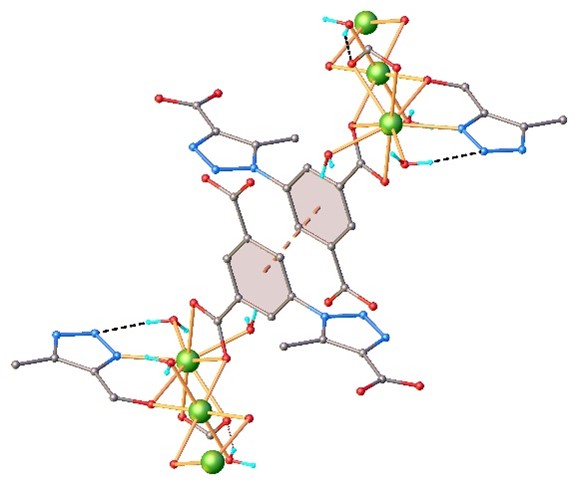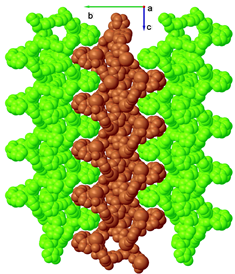Chemistry Journal of Moldova
Inorganic and coordination chemistry
Author(s):
Field: Inorganic and coordination chemistry
Type: Research paper
Issue: 2025 Volume 20, no.2
Pages: 33-44
Mariana Diru, Ion Lungu, Tamara Potlog
Field: Inorganic and coordination chemistry
Type: Research paper
Issue: 2025 Volume 20, no.2
Pages: 33-44
Full Text (PDF): Download
Graphycal Abstract: Two methods for synthesizing MgO nanoparticles using sodium lauryl sulphate and Aloe Vera extract as dispersing agents are described. Varying dispersing agent quantities and calcination temperatures were applied. The morphology and size were characterized using SEM-EDX and XRD, confirming successful synthesis and structure of the MgO nanoparticles.


Downloads: 11
Author(s):
Field: Inorganic and coordination chemistry
Type: Research paper
Issue: 2025 Volume 20, no.2
Pages: 25-32
Viorina Gorinchoy, Sergiu Shova, Olga Kulikova, Gheorghe Roman, Vasile Lozan
Field: Inorganic and coordination chemistry
Type: Research paper
Issue: 2025 Volume 20, no.2
Pages: 25-32
Full Text (PDF): Download
Graphycal Abstract: A new cadmium(II) polymeric complex was synthesized under solvothermal conditions by the reaction of 5-(4-carboxy-5-methyl-1H-1,2,3-triazol-1-yl)isophthalic acid (H3L) with cadmium nitrate tetrahydrate in a mixture of N,N-dimethylacetamide and water. The polymeric complex is an infinite 2D coordination polymer with the general formula {[Cd3L2(H2O)6]·2H2O}n. The two-dimensional coordination polymer {[Cd3L2(H2O)6]}n presents p–p stacking interactions between benzene rings of adjacent 2D coordination polymers, which contribute along with numerous O-H---O H-bonds to the assembly of a 3D supramolecular assembly. The intense photoluminescence emission of cadmium(II) complex is observed in the blue-violet region of the spectrum.


Downloads: 10
Author(s):
Field: Inorganic and coordination chemistry
Type: Research paper
Issue: 2025 Volume 20, no.2
Pages: 15-24
Dumitru Ureche, Pavlina Bourosh, Ion Bulhac
Field: Inorganic and coordination chemistry
Type: Research paper
Issue: 2025 Volume 20, no.2
Pages: 15-24
Full Text (PDF): Download
Graphycal Abstract: The synthesis of three structurally distinct copper(II) coordination compounds with iminodiacetic acid (H₂IDA) as ligand was achieved by varying the reaction pH. Under neutral conditions (pH 6–6.5), compound 1 formed as a two-dimensional ionic coordination polymer, {[NH₂(CH₃)₂]₂[Cu₃(IDA)₄]·1.75H₂O}ₙ, consisting of layered [Cu₃(IDA)₄]²ₙ⁻ anions stabilized by hydrogen-bonding networks. Under basic conditions (pH 8–8.5), compound 2 was obtained as a neutral 2D molecular polymer, {[Cu₃(IDA)₂(IDAH)₂]·5H₂O}ₙ, built from trinuclear copper units bridged by bi- and monodeprotonated ligands. Under acidic conditions (pH 3), compound 3, ((CH₃)₂OH)₂[Cu(IDA)₂]·[Cu(IDAH)₂], was isolated as an ionic structure containing neutral and anionic mononuclear complexes charge-balanced by protonated dimethylether cations.


Downloads: 10
Author(s):
Field: Inorganic and coordination chemistry
Type: Research paper
Issue: 2024 Volume 19, no.2
Pages: 28-35
Kyrylo Tsymbaliuk, Оlena Martsynko, Viktoriya Dyakonenko, Оlena Finik, Inna Seifullina, Svitlana Shishkina
Field: Inorganic and coordination chemistry
Type: Research paper
Issue: 2024 Volume 19, no.2
Pages: 28-35
Full Text (PDF): Download
https://doi.org/10.19261/cjm.2024.1247
Graphycal Abstract: The present study describes synthesis, research and definition of the structure of five new coordination compounds of Germanium(IV) and 3d-metals with 1-hydroxyethane-1,1-diphosphonic acid and 1,10-phenanthroline, which in crystals are organic-inorganic hybrid ensembles with three-dimensional networks formed by numerous intermolecular hydrogen bonds between complex cations, anions, and crystalline water molecules.

Downloads: 57
Author(s):
Field: Inorganic and coordination chemistry
Type: Research paper
Issue: 2024 Volume 19, no.2
Pages: 36-44
Dumitru Ureche, Ion Bulhac, Pavlina Bourosh
Field: Inorganic and coordination chemistry
Type: Research paper
Issue: 2024 Volume 19, no.2
Pages: 36-44
Full Text (PDF): Download
https://doi.org/10.19261/cjm.2024.1212
Abstract (PDF)
Graphycal Abstract: Two new compounds – a mononuclear nickel(II) compound with di-paratolylglyoxime (DpatH2) - [Ni(DpatH2)3]SO4∙1,4-H2bdc∙2.5DMF∙H2O (1) and a binuclear manganese(II) compound with dianilineglyoxime (DAnH2) - [Mn2(DAnH2)2(1,3-bdc)2(DMSO)4] (2) (1,4- and 1,3-bdc are 1,4- and 1,3-benzenedicarboxylic acids, respectively) have been obtained. The IR spectra of the complexes were studied and molecular and crystal structures of the compounds were determined by single crystal X-ray diffraction method. Compound 1 is ionic and contains a complex cation in which three neutral DpatH2 ligands are coordinated to the nickel atom. Complex 2 is a molecular binuclear complex in which, in addition to the two neutral ligands DAnH2 and four DMSO, two 1,3-benzenedicarboxylic anions are coordinated to the metal atoms in a bridging manner.

Downloads: 51
Author(s):
Field: Inorganic and coordination chemistry
Type: Research paper
Issue: 2024 Volume 19, no.1
Pages: 62-68
Viorina Gorinchoy, Olesea Cuzan, Sergiu Shova, Vasile Lozan
Field: Inorganic and coordination chemistry
Type: Research paper
Issue: 2024 Volume 19, no.1
Pages: 62-68
Full Text (PDF): Download
https://doi.org/10.19261/cjm.2024.1168
Abstract (PDF)
Graphical Abstract: A new heterometallic iron(III) compound, derivative of salicylic acid, catena–poly[bis(methanol)-bis(N,N–dimethylacetamide)–tris(m–salicylato)–bis(m–salicyl)–dicalcium(II) iron(III)], has been synthesized and characterized by infrared spectroscopy, single-crystal X-ray diffraction and elemental analysis. Single-crystal X-ray diffraction study revealed that synthesized compound forms an 1D coordination polymer with general formula {[FeCa2(Sal)2(SalH)3 (DMA)2(CH3OH)2]}n. The compound crystallizes in the P21/c space group of the monoclinic system with the following unit cell parameters: а= 9.76785(9), b= 37.3386(4), c= 13.82575(12) Å, β= 103.6421(9)°, Z= 4. The independent unit cell of the obtained compound contains one iron and two calcium ions, in which the iron(III) ion has an octahedral coordination sphere. The different coordination modes of the five molecules of salicylic anions revealed by IR analysis were confirmed by X-ray studies, showing that the salicylate anions play the role of bridging ligands and coordinate in three different ways, thus the carboxylic group forms bridges through three different coordination pathways, namely: bidentate, tridentate and pentadentate fashion.

Downloads: 109
Author(s):
Field: Inorganic and coordination chemistry
Type: Research paper
Issue: 2023 Volume 18, no.2
Pages: 61-68
Eleonora Afanasenko, Inna Seifullina, Elena Martsinko, Viktoriya Dyakonenko, Svitlana Shishkina
Field: Inorganic and coordination chemistry
Type: Research paper
Issue: 2023 Volume 18, no.2
Pages: 61-68
Full Text (PDF): Download
https://doi.org/10.19261/cjm.2023.1121
Abstract (PDF)
Supplementary Material (PDF)
Graphical Abstract: The present study extends the research and describes synthesis strategy, structural properties and biological activity of complex compound (HPhen)4[(µ-O){Ge2(OH)(µ-Tart)2}2]·9H2O, which comprises a tartratogermanate anion and the protonated form of 1,10-phenanthroline as the cationic component.

Downloads: 119
Author(s):
Field: Inorganic and coordination chemistry
Type: Research paper
Issue: 2023 Volume 18, no.2
Pages: 53-60
Natalia Talmaci, Diana Dragancea, Elena Gorincioi, Pavlina Bourosh, Victor Kravtsov
Field: Inorganic and coordination chemistry
Type: Research paper
Issue: 2023 Volume 18, no.2
Pages: 53-60
Full Text (PDF): Download
Abstract (PDF)
Supplementary Material (PDF)
Graphical Abstract: The crystal structure of 1,5-bis(2-hydroxy-3-methoxybenzylidene) carbonohydrazide was determined by X-ray single crystal diffraction study. In solid-state the molecule adopts the anti keto conformation, while NMR studies proved evidence on the presence of its syn tautomer in DMSO solution.
Supplementary Material (PDF)
Graphical Abstract: The crystal structure of 1,5-bis(2-hydroxy-3-methoxybenzylidene) carbonohydrazide was determined by X-ray single crystal diffraction study. In solid-state the molecule adopts the anti keto conformation, while NMR studies proved evidence on the presence of its syn tautomer in DMSO solution.

Downloads: 115
Author(s):
Field: Inorganic and coordination chemistry
Type: Research paper
Issue: 2023 Volume 18, no.1
Pages: 77-85
Masahiro Mikuriya, Shun Kawauchi, Ryoji Mitsuhashi, Motohiro Tsuboi, Makoto Handa
Field: Inorganic and coordination chemistry
Type: Research paper
Issue: 2023 Volume 18, no.1
Pages: 77-85
Full Text (PDF): Download
https://doi.org/10.19261/cjm.2023.1059
Abstract (PDF)
Graphical Abstract: A heterometal complex [RuIIRuIII(n-C3H7COO)4AuIII(CN)4]n was synthesized. The X-ray crystallography elucidated a chain molecule of alternating arrangement of Ru2(n-C3H7COO)4+ and Au(CN)4– units with cis-bridging mode. Magnetic susceptibility data showed that magnetic interaction between RuIIRuIII units (S= 3/2) is negligible small with a zero-field splitting parameter D of 60 cm–1.
Downloads: 110
Author(s):
Field: Inorganic and coordination chemistry
Type: Research paper
Issue: 2023 Volume 18, no.1
Pages: 70-76
Irina Voda
Field: Inorganic and coordination chemistry
Type: Research paper
Issue: 2023 Volume 18, no.1
Pages: 70-76
Full Text (PDF): Download
Abstract (PDF)
Graphical Abstract: The use of a pillar bridging ligand coordinating through two imidazole rings and multidentate carboxylate ligand with zinc(II) generates a bidimentional coordination polymer {[Zn3(BIBPh)3(BTC)2]∙H2O}n. It has been structurally characterised and investigated by IR and thermogravimetric methods. Each metal ion is four coordinated exhibiting a slightly distorted tetrahedral coordination.

Graphical Abstract: The use of a pillar bridging ligand coordinating through two imidazole rings and multidentate carboxylate ligand with zinc(II) generates a bidimentional coordination polymer {[Zn3(BIBPh)3(BTC)2]∙H2O}n. It has been structurally characterised and investigated by IR and thermogravimetric methods. Each metal ion is four coordinated exhibiting a slightly distorted tetrahedral coordination.
Downloads: 98






